Abstract
Listeria monocytogenes F5069 was suspended in either Trypticase soy broth-0.6% yeast extract (TSBYE) or sterile, whole milk and heated at 62.8 degrees C in sealed thermal death time tubes. Severely heat-injured cells were recovered in TSBYE within sealed thermal death time tubes because of the formation of reduced conditions in the depths of the TSBYE. Also, the use of strictly anaerobic Hungate techniques significantly increased recovery in TSBYE containing 1.5% agar compared with aerobically incubated controls. The exogenous addition of catalase, but not superoxide dismutase, slightly increased the recovery of heat-injured cells in TSBYE containing 1.5% agar incubated aerobically. Growth of cells at 43 degrees C caused a greater increase in heat resistance as compared with cells heat shocked at 43 degrees C or cells grown at lower temperatures. Growth of L. monocytogenes at 43 degrees C and enumeration by the use of strictly anaerobic Hungate techniques resulted in D62.8 degrees C values that were at least sixfold greater than those previously obtained by using cells grown at 37 degrees C and aerobic plating. Results indicate that, under the conditions of the present study, high levels of L. monocytogenes would survive the minimum low-temperature, long-time treatment required by the U.S. Food and Drug Administration for pasteurizing milk. The possible survival of low levels of L. monocytogenes during high-temperature, short-time pasteurization and enumeration of injured cells by recovery on selective media under strictly anaerobic conditions are discussed.
Full text
PDF
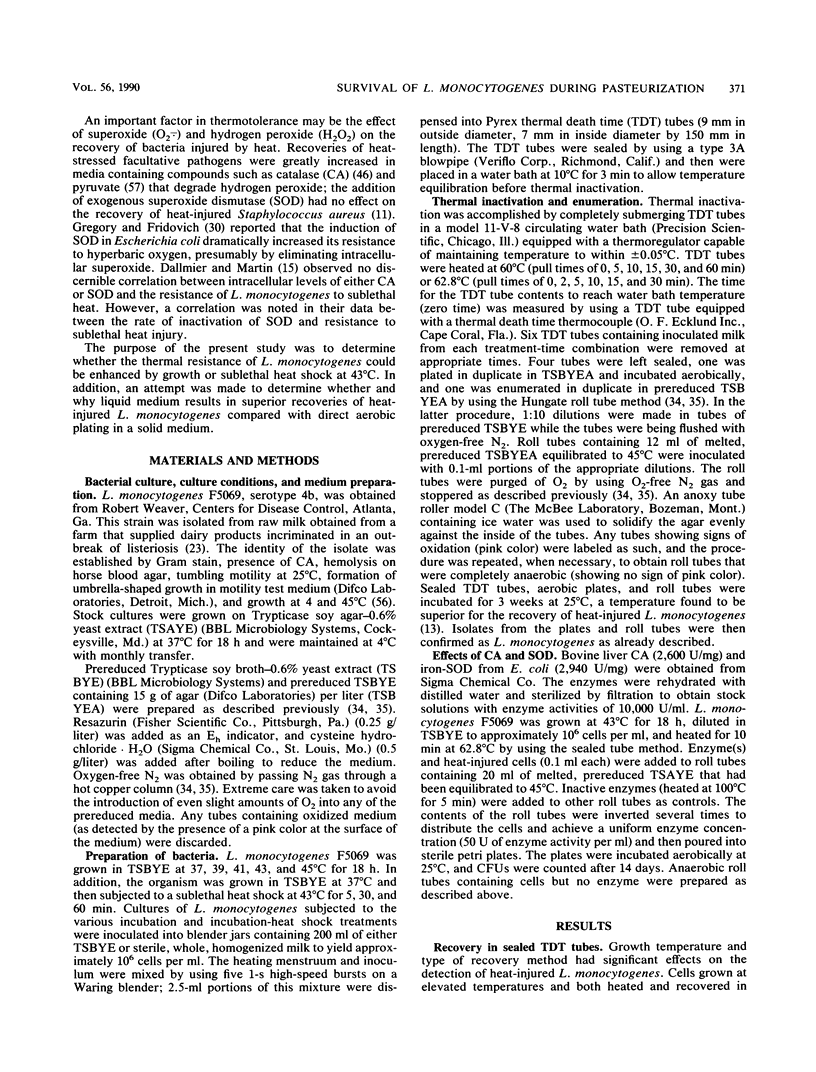
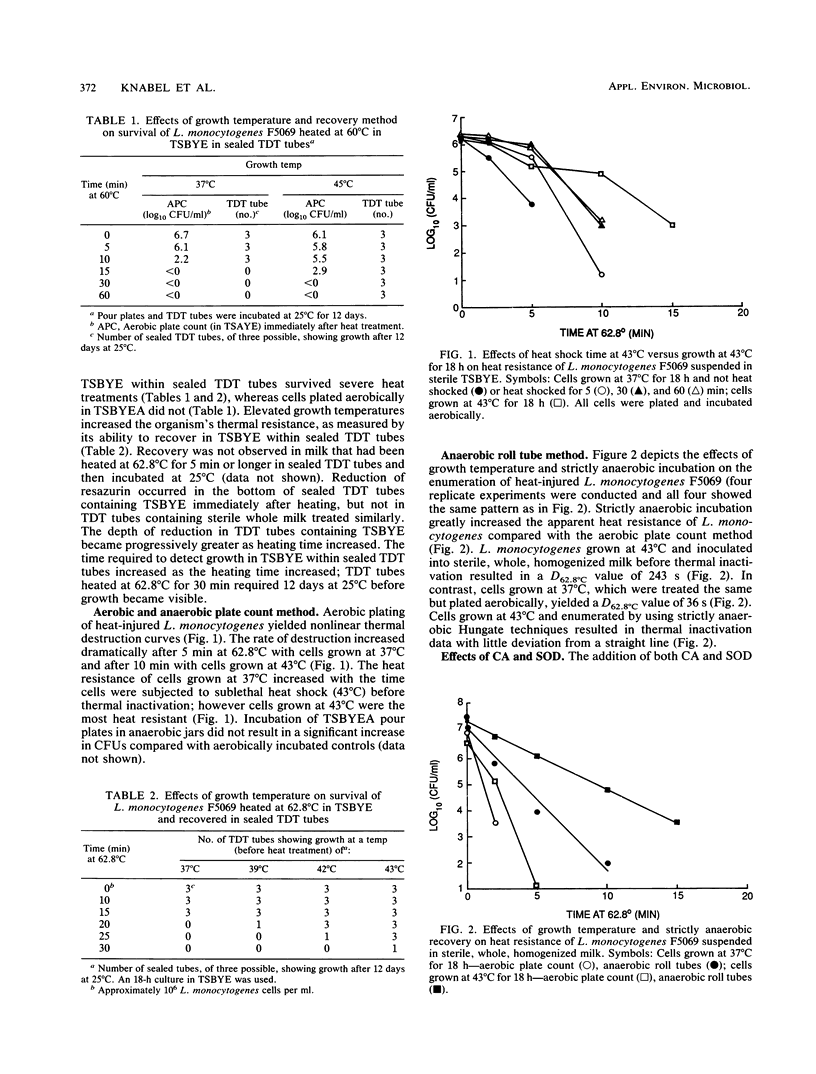
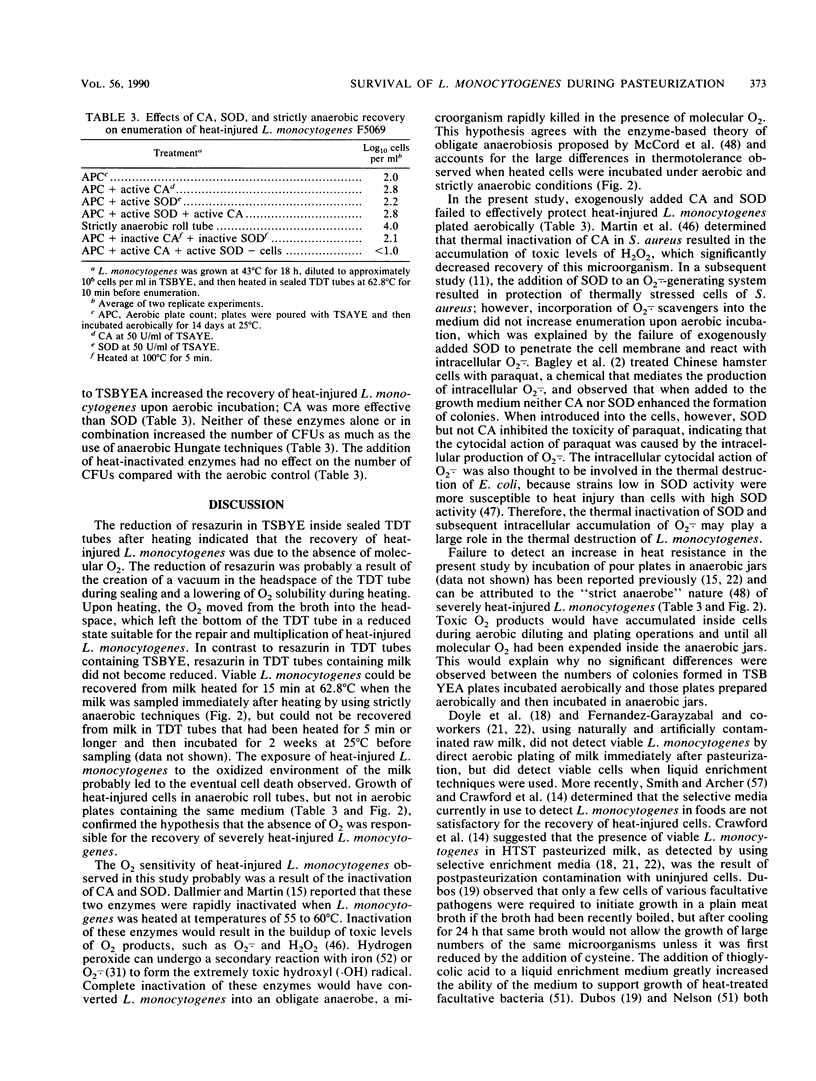
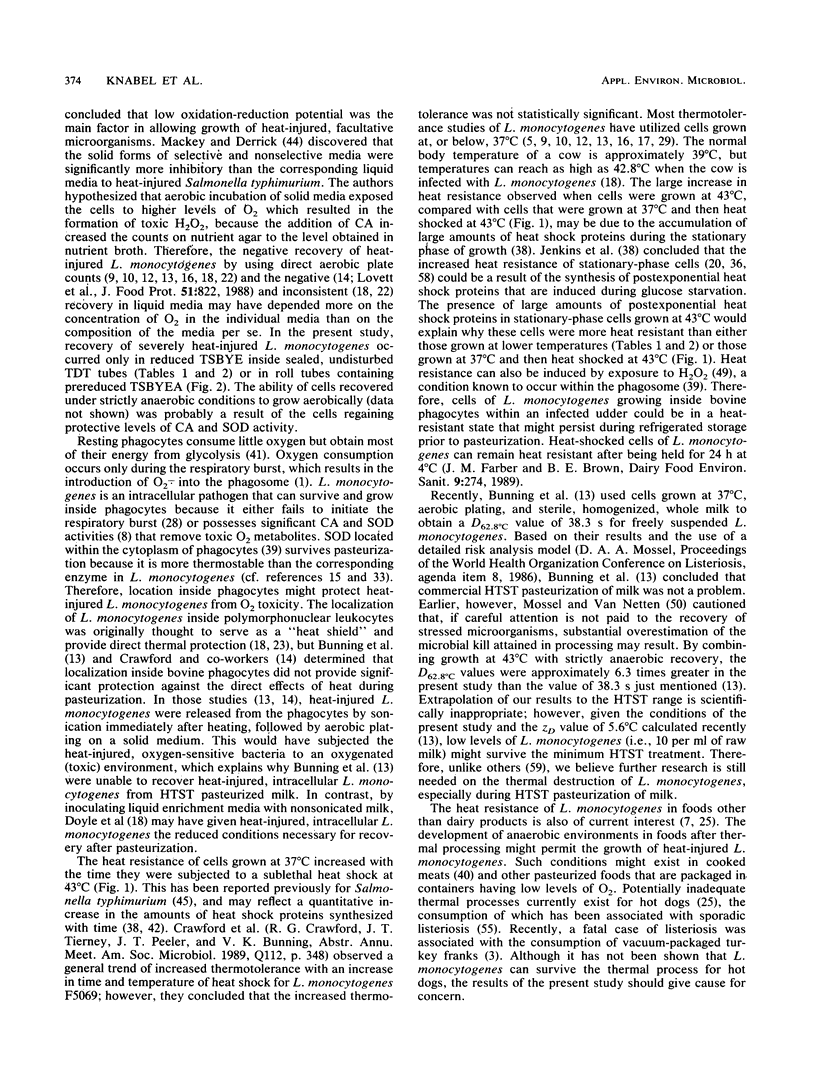

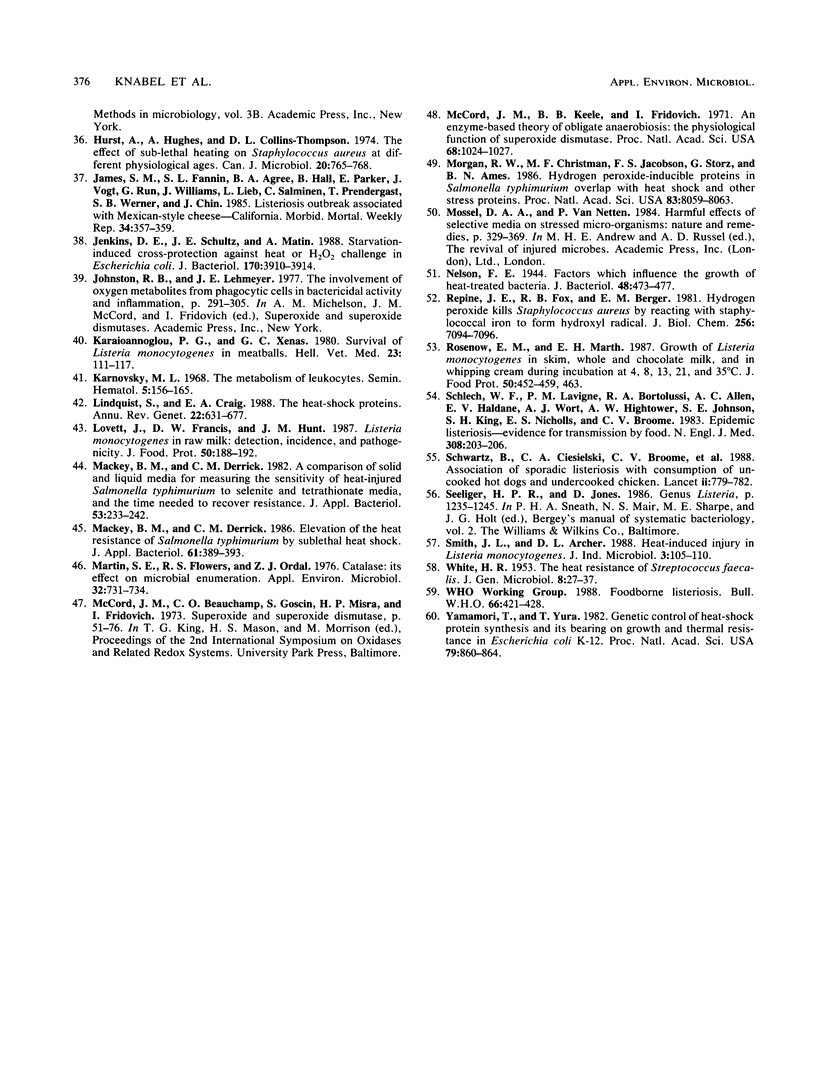
Selected References
These references are in PubMed. This may not be the complete list of references from this article.
- BEARNS R. E., GIRARD K. F. The effect of pasteurization on Listeria monocytogenes. Can J Microbiol. 1958 Feb;4(1):55–61. doi: 10.1139/m58-007. [DOI] [PubMed] [Google Scholar]
- Babior B. M. The respiratory burst of phagocytes. J Clin Invest. 1984 Mar;73(3):599–601. doi: 10.1172/JCI111249. [DOI] [PMC free article] [PubMed] [Google Scholar]
- Bagley A. C., Krall J., Lynch R. E. Superoxide mediates the toxicity of paraquat for Chinese hamster ovary cells. Proc Natl Acad Sci U S A. 1986 May;83(10):3189–3193. doi: 10.1073/pnas.83.10.3189. [DOI] [PMC free article] [PubMed] [Google Scholar]
- Beuchat L. R., Brackett R. E., Hao D. Y., Conner D. E. Growth and thermal inactivation of Listeria monocytogenes in cabbage and cabbage juice. Can J Microbiol. 1986 Oct;32(10):791–795. doi: 10.1139/m86-145. [DOI] [PubMed] [Google Scholar]
- Beuchat L. R. Injury and repair of gram-negative bacteria, with special consideration of the involvement of the cytoplasmic membrane. Adv Appl Microbiol. 1978;23:219–243. doi: 10.1016/s0065-2164(08)70071-6. [DOI] [PubMed] [Google Scholar]
- Bortolussi R., Vandenbroucke-Grauls C. M., van Asbeck B. S., Verhoef J. Relationship of bacterial growth phase to killing of Listeria monocytogenes by oxidative agents generated by neutrophils and enzyme systems. Infect Immun. 1987 Dec;55(12):3197–3203. doi: 10.1128/iai.55.12.3197-3203.1987. [DOI] [PMC free article] [PubMed] [Google Scholar]
- Bucker E. R., Martin S. E. Effect of free-radical scavengers on enumeration of thermally stressed cells of Staphylococcus aureus MF-31. Appl Environ Microbiol. 1982 May;43(5):1020–1025. doi: 10.1128/aem.43.5.1020-1025.1982. [DOI] [PMC free article] [PubMed] [Google Scholar]
- Bunning V. K., Crawford R. G., Bradshaw J. G., Peeler J. T., Tierney J. T., Twedt R. M. Thermal resistance of intracellular Listeria monocytogenes cells suspended in raw bovine milk. Appl Environ Microbiol. 1986 Dec;52(6):1398–1402. doi: 10.1128/aem.52.6.1398-1402.1986. [DOI] [PMC free article] [PubMed] [Google Scholar]
- Bunning V. K., Donnelly C. W., Peeler J. T., Briggs E. H., Bradshaw J. G., Crawford R. G., Beliveau C. M., Tierney J. T. Thermal inactivation of Listeria monocytogenes within bovine milk phagocytes. Appl Environ Microbiol. 1988 Feb;54(2):364–370. doi: 10.1128/aem.54.2.364-370.1988. [DOI] [PMC free article] [PubMed] [Google Scholar]
- Crawford R. G., Beliveau C. M., Peeler J. T., Donnelly C. W., Bunning V. K. Comparative recovery of uninjured and heat-injured Listeria monocytogenes cells from bovine milk. Appl Environ Microbiol. 1989 Jun;55(6):1490–1494. doi: 10.1128/aem.55.6.1490-1494.1989. [DOI] [PMC free article] [PubMed] [Google Scholar]
- Dallmier A. W., Martin S. E. Catalase and superoxide dismutase activities after heat injury of Listeria monocytogenes. Appl Environ Microbiol. 1988 Feb;54(2):581–582. doi: 10.1128/aem.54.2.581-582.1988. [DOI] [PMC free article] [PubMed] [Google Scholar]
- Doyle M. P., Glass K. A., Beery J. T., Garcia G. A., Pollard D. J., Schultz R. D. Survival of Listeria monocytogenes in milk during high-temperature, short-time pasteurization. Appl Environ Microbiol. 1987 Jul;53(7):1433–1438. doi: 10.1128/aem.53.7.1433-1438.1987. [DOI] [PMC free article] [PubMed] [Google Scholar]
- Elliker P. R., Frazier W. C. Influence of Time and Temperature of Incubation on Heat Resistance of Escherichia coli. J Bacteriol. 1938 Jul;36(1):83–98. doi: 10.1128/jb.36.1.83-98.1938. [DOI] [PMC free article] [PubMed] [Google Scholar]
- Fernandez Garayzabal J. F., Dominguez Rodriguez L., Vazquez Boland J. A., Rodriguez Ferri E. F., Briones Dieste V., Blanco Cancelo J. L., Suarez Fernandez G. Survival of Listeria monocytogenes in raw milk treated in a pilot plant size pasteurizer. J Appl Bacteriol. 1987 Dec;63(6):533–537. doi: 10.1111/j.1365-2672.1987.tb02723.x. [DOI] [PubMed] [Google Scholar]
- Fernández Garayzábal J. F., Domínguez Rodríguez L., Vázquez Boland J. A., Blanco Cancelo J. L., Suárez Fernández G. Listeria monocytogenes dans le lait pasteurisé. Can J Microbiol. 1986 Feb;32(2):149–150. [PubMed] [Google Scholar]
- Fleming D. W., Cochi S. L., MacDonald K. L., Brondum J., Hayes P. S., Plikaytis B. D., Holmes M. B., Audurier A., Broome C. V., Reingold A. L. Pasteurized milk as a vehicle of infection in an outbreak of listeriosis. N Engl J Med. 1985 Feb 14;312(7):404–407. doi: 10.1056/NEJM198502143120704. [DOI] [PubMed] [Google Scholar]
- Fridovich I. Biological effects of the superoxide radical. Arch Biochem Biophys. 1986 May 15;247(1):1–11. doi: 10.1016/0003-9861(86)90526-6. [DOI] [PubMed] [Google Scholar]
- Gitter M., Bradley R., Blampied P. H. Listeria monocytogenes infection in bovine mastitis. Vet Rec. 1980 Oct 25;107(17):390–393. doi: 10.1136/vr.107.17.390. [DOI] [PubMed] [Google Scholar]
- Godfrey R. W., Wilder M. S. Relationships between oxidative metabolism, macrophage activation, and antilisterial activity. J Leukoc Biol. 1984 Oct;36(4):533–543. doi: 10.1002/jlb.36.4.533. [DOI] [PubMed] [Google Scholar]
- Gregory E. M., Fridovich I. Oxygen toxicity and the superoxide dismutase. J Bacteriol. 1973 Jun;114(3):1193–1197. doi: 10.1128/jb.114.3.1193-1197.1973. [DOI] [PMC free article] [PubMed] [Google Scholar]
- Hicks C. L., Bucy J., Stofer W. Heat inactivation of superoxide dismutase in bovine milk. J Dairy Sci. 1979 Apr;62(4):529–532. doi: 10.3168/jds.S0022-0302(79)83285-3. [DOI] [PubMed] [Google Scholar]
- Hurst A., Hughes A., Collins-Thompson D. L. The effect of sublethal heating on Staphylococcus aureus at different physiological ages. Can J Microbiol. 1974 May;20(5):765–768. doi: 10.1139/m74-117. [DOI] [PubMed] [Google Scholar]
- Jenkins D. E., Schultz J. E., Matin A. Starvation-induced cross protection against heat or H2O2 challenge in Escherichia coli. J Bacteriol. 1988 Sep;170(9):3910–3914. doi: 10.1128/jb.170.9.3910-3914.1988. [DOI] [PMC free article] [PubMed] [Google Scholar]
- Karnovsky M. L. The metabolism of leukocytes. Semin Hematol. 1968 Apr;5(2):156–165. [PubMed] [Google Scholar]
- Lindquist S., Craig E. A. The heat-shock proteins. Annu Rev Genet. 1988;22:631–677. doi: 10.1146/annurev.ge.22.120188.003215. [DOI] [PubMed] [Google Scholar]
- Mackey B. M., Derrick C. M. A comparison of solid and liquid media for measuring the sensitivity of heat-injured Salmonella typhimurium to selenite and tetrathionate media, and the time needed to recover resistance. J Appl Bacteriol. 1982 Oct;53(2):233–242. doi: 10.1111/j.1365-2672.1982.tb04682.x. [DOI] [PubMed] [Google Scholar]
- Mackey B. M., Derrick C. M. Elevation of the heat resistance of Salmonella typhimurium by sublethal heat shock. J Appl Bacteriol. 1986 Nov;61(5):389–393. doi: 10.1111/j.1365-2672.1986.tb04301.x. [DOI] [PubMed] [Google Scholar]
- Martin S. E., Flowers R. S., Ordal Z. J. Catalase: its effect on microbial enumeration. Appl Environ Microbiol. 1976 Nov;32(5):731–734. doi: 10.1128/aem.32.5.731-734.1976. [DOI] [PMC free article] [PubMed] [Google Scholar]
- McCord J. M., Keele B. B., Jr, Fridovich I. An enzyme-based theory of obligate anaerobiosis: the physiological function of superoxide dismutase. Proc Natl Acad Sci U S A. 1971 May;68(5):1024–1027. doi: 10.1073/pnas.68.5.1024. [DOI] [PMC free article] [PubMed] [Google Scholar]
- Morgan R. W., Christman M. F., Jacobson F. S., Storz G., Ames B. N. Hydrogen peroxide-inducible proteins in Salmonella typhimurium overlap with heat shock and other stress proteins. Proc Natl Acad Sci U S A. 1986 Nov;83(21):8059–8063. doi: 10.1073/pnas.83.21.8059. [DOI] [PMC free article] [PubMed] [Google Scholar]
- Mossel D. A., Van Netten P. Harmful effects of selective media on stressed micro-organisms: nature and remedies. Soc Appl Bacteriol Symp Ser. 1984;(12):329–369. [PubMed] [Google Scholar]
- Nelson F. E. Factors Which Influence the Growth of Heat-treated Bacteria: II. Further Studies on Media. J Bacteriol. 1944 Oct;48(4):473–477. doi: 10.1128/jb.48.4.473-477.1944. [DOI] [PMC free article] [PubMed] [Google Scholar]
- Repine J. E., Fox R. B., Berger E. M. Hydrogen peroxide kills Staphylococcus aureus by reacting with staphylococcal iron to form hydroxyl radical. J Biol Chem. 1981 Jul 25;256(14):7094–7096. [PubMed] [Google Scholar]
- Schlech W. F., 3rd, Lavigne P. M., Bortolussi R. A., Allen A. C., Haldane E. V., Wort A. J., Hightower A. W., Johnson S. E., King S. H., Nicholls E. S. Epidemic listeriosis--evidence for transmission by food. N Engl J Med. 1983 Jan 27;308(4):203–206. doi: 10.1056/NEJM198301273080407. [DOI] [PubMed] [Google Scholar]
- Schwartz B., Ciesielski C. A., Broome C. V., Gaventa S., Brown G. R., Gellin B. G., Hightower A. W., Mascola L. Association of sporadic listeriosis with consumption of uncooked hot dogs and undercooked chicken. Lancet. 1988 Oct 1;2(8614):779–782. doi: 10.1016/s0140-6736(88)92425-7. [DOI] [PubMed] [Google Scholar]
- WHITE H. R. The heat resistance of Streptococcus faecalis. J Gen Microbiol. 1953 Feb;8(1):27–37. doi: 10.1099/00221287-8-1-27. [DOI] [PubMed] [Google Scholar]
- Yamamori T., Yura T. Genetic control of heat-shock protein synthesis and its bearing on growth and thermal resistance in Escherichia coli K-12. Proc Natl Acad Sci U S A. 1982 Feb;79(3):860–864. doi: 10.1073/pnas.79.3.860. [DOI] [PMC free article] [PubMed] [Google Scholar]


